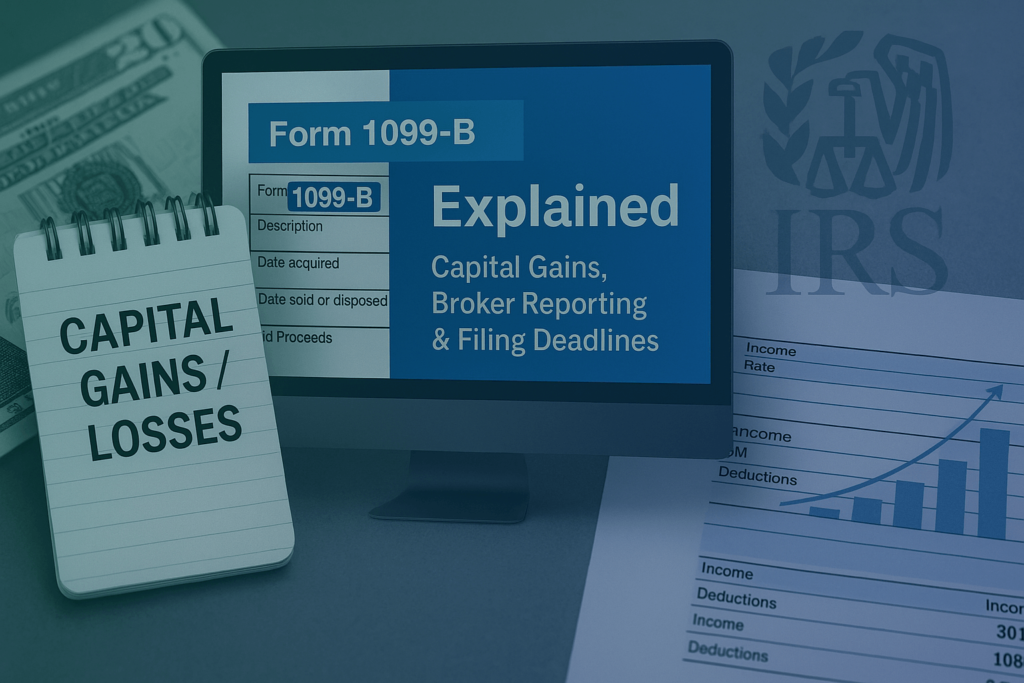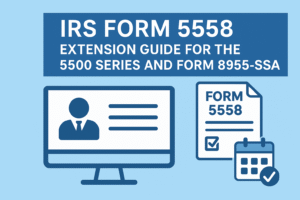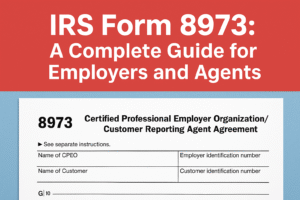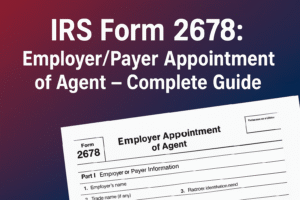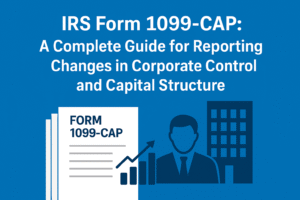If you’ve sold stocks, bonds, mutual funds, or other securities through a broker, chances are you’ve encountered IRS Form 1099-B. This form plays a critical role in reporting capital gains and losses on your federal tax return. Whether you’re a taxpayer receiving the form or a brokerage required to file it, understanding the ins and outs of Form 1099-B is essential for staying compliant with IRS rules.
This comprehensive guide will walk you through everything you need to know—from who files it, key deadlines, how to complete it, to the penalties for non-compliance.
What Is Form 1099-B?
Form 1099-B, Proceeds From Broker and Barter Exchange Transactions, is an IRS information return that brokers and barter exchanges must file to report:
- Sales of stocks, bonds, commodities, or other securities
- Redemptions of mutual fund shares
- Certain barter transactions
It provides essential information about each transaction, including sale date, proceeds, cost basis, and gain or loss, which the taxpayer uses to report capital gains and losses on Schedule D (Form 1040).
The IRS uses this form to ensure taxpayers correctly report income from asset sales and pay any required taxes on investment gains.
Who Must File Form 1099-B?
Brokers and Barter Exchanges
Form 1099-B must be filed by:
- Brokers (including stockbrokers, mutual fund companies, robo-advisors)
- Barter exchanges (entities that coordinate barter transactions between parties)
These entities must report all applicable transactions executed on behalf of a client or account holder.
Real-Time Examples:
- Example 1: John sells 100 shares of Apple stock through Fidelity. Fidelity is required to file Form 1099-B showing the proceeds and cost basis of the sale.
- Example 2: A barter exchange facilitates a transaction where a graphic designer trades services for a used laptop. The exchange files Form 1099-B to both parties reporting the fair market value of the exchanged items.
When Is the Deadline to File 1099-B?
Here are the important deadlines:
| Action | Due Date |
| Furnish Copy B to recipient (investor) | February 18, 2025 |
| File with IRS (paper filing) | February 28, 2025 |
| File with IRS (electronic filing) | April 1, 2025 |
Note: If February 15 (the usual deadline) falls on a weekend or holiday, the due date shifts to the next business day, hence the February 18 deadline in 2025.
Information Required to Complete 1099-B
To complete Form 1099-B accurately, the following information is needed for each reportable transaction:
- Name, address, and TIN of the recipient (investor)
- CUSIP number or description of the security
- Date of acquisition and date of sale
- Gross proceeds from the sale
- Cost or adjusted basis
- Whether the gain or loss is short-term or long-term
- Federal income tax withheld, if any
- Any applicable codes (e.g., for wash sales, noncovered securities)
Before filing a Form 1099-B, brokers often require the account holder or investor to complete IRS Form W-9 (Request for Taxpayer Identification Number and Certification) for accurate reporting.
How to Complete Form 1099-B (Box-by-Box Guide)
Let’s break down each key part of the form:
Box 1a – Description of property
Enter a brief description of the security (e.g., “100 sh. ABC Corp”).
Box 1b – Date acquired
Enter the date the asset was originally acquired (if known/applicable).
Box 1c – Date sold or disposed
Indicate the sale or disposition date.
Box 1d – Proceeds
Enter the gross proceeds received by the investor.
Box 1e – Cost or other basis
Show the original purchase price or adjusted basis.
Box 1f – Accrued market discount
If applicable, enter market discount accrued during the holding period.
Box 1g – Wash sale loss disallowed
If the transaction triggers a wash sale, enter the disallowed amount here.
Box 2 – Type of gain or loss
Use code to indicate short-term (S) or long-term (L) holding period.
Box 3 – Check if basis is reported to IRS
Tick this box if it’s a covered security (i.e., cost basis reported to IRS).
Box 4 – Federal income tax withheld
Enter any backup withholding or other federal tax withheld.
Boxes 5 to 12 – Additional details
Include bartering info, original issue discount, and foreign tax, if relevant.
Copies of Form 1099-B
Form 1099-B has multiple parts:
- Copy A – Sent to IRS
- Copy B – Sent to recipient (taxpayer)
- Copy C – Retained by the filer (broker)
- Copy 1 – Sent to state tax department (if applicable)
- Copy 2 – Used for recipient’s state tax return
How to File Form 1099-B
There are two main filing methods:
Paper Filing
Use Form 1096 as the transmittal form. Suitable for filers submitting fewer than 10 forms.
Electronic Filing
Required if filing 10 or more forms in a calendar year. Use the FIRE system (Filing Information Returns Electronically) provided by the IRS.
Note: As of 2024, the threshold for mandatory e-filing was reduced from 250 to 10 information returns.
What Are the Penalties for Not Filing 1099-B?
Failure to file correctly and on time can result in steep penalties:
| Time of Filing | Penalty per Form | Max Annual Penalty |
| Within 30 days | $60 | $630,500 ($220,500 for small businesses) |
| 31 days – Aug 1 | $120 | $1,891,500 |
| After August 1 / Not filed | $310 | $3,783,000 |
Intentional disregard of filing rules can result in a minimum penalty of $630 per form with no maximum limit.
How to Extend 1099-B Filing and Recipient Copy Deadline
You can request an extension for:
IRS Filing Deadline
File Form 8809 by the original due date to get an automatic 30-day extension.
Furnishing Copy to Recipients
Use Form 15397 to request an extension to provide Copy B to recipients. Approval is not automatic.
Who Is Exempt From Filing 1099-B?
Generally, brokers and barter exchanges must file, but some exemptions include:
- Sales of non-covered securities where cost basis isn’t required to be reported
- Corporations receiving payments (generally exempt from reporting unless backup withholding applies)
- Transactions not executed through a broker
However, most brokerage firms still provide consolidated 1099 statements for all transactions for consistency and transparency.
Do You Need to File Form 1099-B for a Foreign Recipient?
In most cases, brokers do not need to file Form 1099-B for foreign recipients—meaning individuals or entities that are not considered U.S. persons for tax purposes. However, there are some important details to keep in mind.
When You Typically Don’t File
If the recipient is a:
- Nonresident alien
- Foreign corporation or partnership
- Foreign trust or estate
…and the income is not connected to a U.S. trade or business, then Form 1099-B is usually not required.
Instead, brokers should collect IRS Form W-8BEN (for individuals) or Form W-8BEN-E (for entities). These forms certify that the person or business is foreign and helps the broker avoid unnecessary IRS reporting or withholding.
When You Might Still Need to Report
In some cases, reporting may still be required, such as:
- If the foreign recipient doesn’t submit a valid W-8 form
- If the income is effectively connected to a U.S. trade or business
- If the broker operates through a U.S. office, and the foreign status isn’t properly certified.
What Should the Recipient Do With Form 1099-B?
Taxpayers who receive Form 1099-B should:
- Review all reported transactions for accuracy.
- Use the form to complete Form 8949 and Schedule D (Form 1040) to report capital gains or losses.
- Retain the form for their records, even if no tax is due.
Failure to report the transactions can trigger an IRS notice or audit.
Final Thoughts
Form 1099-B plays a critical role in the tax reporting ecosystem for both brokers and investors. It ensures that capital gains and losses are accurately captured and taxed. Brokers and barter exchanges must be diligent in filing on time and furnishing correct information to avoid IRS penalties. Investors, on the other hand, must review the data and properly report it to avoid tax issues.
Whether you’re issuing or receiving Form 1099-B, understanding its structure and deadlines is key to remaining tax-compliant in a world of increasingly automated and transparent financial reporting.

